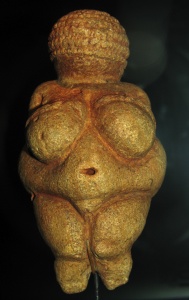
Sando Botticelli, The Birth of Venus, 1486
I’ve long loved Botticelli’s The Birth of Venus, as has much of the Western world. Odd, then, that this woman probably wouldn’t make the cover of a magazine today. More thigh than thigh gap, the goddess of love doesn’t meet our beauty standards.
She’s not quite a Venus of Willendorf but her stance is similar – thighs pressed together to the knee, one foot firmly planted as she steps towards us. The artist’s emphasis on her abdomen is similar, too. Like the older fertility goddess, her belly button draws our eye to her torso which is center, central, and soft. Her sensuality stems from what is there not, like the thigh gap fetish, from what is missing.
- Venus of Willendorf, c. 28,000 to 25,000 BCE
- Sandro Botticelli, detail from The Birth of Venus, 1486
But if she’s not quite of Willendorf, Botticelli’s Venus isn’t quite of the contemporary western world, either. Here’s what today’s “perfect woman” looks like per a recent survey by British lingerie maker Bluebella:

Still stepping forward but now on stilettos, this figure has lost some of Venus’s stability. And some of her figure too.
Perhaps Botticelli’s Venus isn’t of today’s so-called first world because her beauty hasn’t been bought in – or bought into in – a capitalist economy. Unlike Bluebella’s chimeras, she isn’t made or imagined by assembly line. She comes before, as Thought Catalog’s Jessica Blankenship writes of Bluebella’s composites, we “reduced people to interchangeable parts.”
Botticelli’s Venus comes before bodies were only parts and labor. Before a well-fed middle class had time to fixate on activating accessory muscles and burning belly fat. Embedded now in our language and ideals now is the demand that we burn our bourgeois bellies. But as the Venus of Willendorf reminds us, that’s where we create life. Perhaps we shouldn’t singe that part of us off. Fat develops our brains, protects us as we move through the world, and gives us the energy to create, birth, and nurse our children. Fat makes us intelligent, dynamic, and lasting creatures. Perhaps we shouldn’t indiscriminately rid ourselves of it.
It can be argued that women today do more physically than Botticelli’s noble model la bella Simonetta might have. So we sculpt our bodies to accommodate our active lifestyles. And we know more about health and fitness now than we did hundreds of years ago. This is a good thing. But unlike an artist’s model, I don’t have to pose in the nude or perform my active life, per the expectations of magazine covers and body image surveys, in a bikini. Why should my belly be flat and my thighs gap?
Botticelli’s Venus seems more at peace than postmodern aesthetics allow. She lives in a time before we trained at fitness boot camps and fell on our own swords via Botox-filled needles. Before we were at war with our own bodies.
More than natural, Venus is a piece of nature itself. Hesiod tells us that she’s fathered by Uranus, literally the sky, and the ocean that moves her to shore. Of course she is. The moon moves the ocean’s tides and moves women’s cycles, too. Like us, Botticelli’s Venus is the stuff of planets, power, and legend. Something to believe in. And not believe in, too. Hesiod tells one story but there are others. And after all, she’s just a painting. Just one woman as imagined by one man.
But she’s more real than today’s imagination of beauty and seduction. For the way we achieve that would-be ideal, see Frederic Doazan’s disturbing if only two minute film “Supervenus.”
Like Doazan’s model, Botticelli’s Venus bleeds. She’s birthed both gods and mortals. At her own birth she’s moved by waves and presumably, like mortal women, the moon. But if so, she bleeds by nature, not for a cause.
But as Doazan’s film dramatizes, it seems I’ll lose less blood with a body like Aphrodite’s than with today’s cultural construct of beauty. I don’t want to be a martyr. So for me at least, it’s still Botticelli’s Venus – all of her.


Botticelli’s Venus would probably be considered “fat” nowadays… It is interesting how the stereotypes of what Beauty is supposed to be like have changed…
Regardless I still believe that “Beauty is in the Eye of the Beholder”/…
All the best to you. Thanks for the great post and for linking back to my blog!. Aquileana 😀
Personally, I think the fat venuses are charming. There’a a lot to them, metaphorically speakimg.
And thanks for fleshing out my gestures to mythological figures with your comprehensive work!
You are most welcome! … By the way, I nominated you for a Very Inspiring Blogger Award. Please check it out here: https://aquileana.wordpress.com/2015/01/02/%E2%96%BAgreek-mythology-the-sirens-muses-of-the-lower-world/ Best wishes for 2015, Aquileana 😀